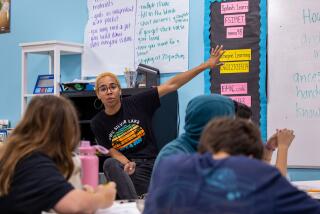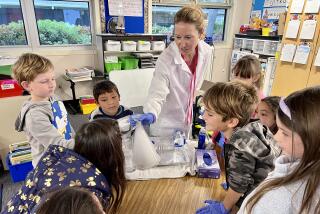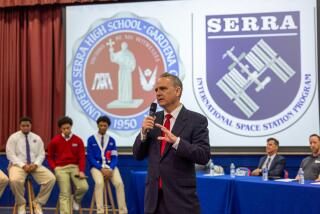The World of Science in a Shoe Box : School’s Specialist Teacher Works With Young Students
- Share via
For those who have wondered how clouds appear in the sky or what the scientific reason is for muddy water, the children at Portrero Heights Elementary School can probably answer those questions and more.
Every day at the school, 35 to 50 kindergarten through fourth-grade children choose from 98 “shoe box” experiments complete with supplies and explanations to take home and do at night. Often the junior scientists work with their parents, who learn along with them.
Experiment No. 87 is Muddy Waters. When a chunk of dirt dissolves in a jar of water, the students learn the theory of dissipation. Or they can take home No. 57, Make a Cloud. The exercise comes with a peanut butter jar. The child pours in hot water and then covers the top with a tray of ice cubes. The instructions then explain that when air at different temperatures collide, a cloud is formed.
The shoe box experiments are part of a pioneering science program at the South San Gabriel school, the only one in the Montebello Unified School District that has hired one person just to teach science to all of the school’s 17 classes. The program, paid for with $50,000 from the state for school improvements, began last spring.
“Science, physical education and math often get shortchanged. Science became No. 1 because of the interests of the community. This is the kind of community interested in higher education, with high expectations,” said Richard F. Pulice, Portrero Heights principal.
One of the parents happy with the program is Lillian Gotanda, mother of 8-year-old Linsey.
‘World Has Opened Up’
“The world has opened up for Linsey. She has learned things about living, stars and humanity. It has to start at this age,” Gotanda said.
Since the classes began, she said, her daughter wants the family to go places--like the planetarium, the Jet Propulsion Lab and the California Museum of Science and Industry.
“I never would have thought of taking her there,” Gotanda said.
Besides getting parents involved in their children’s education and making science more digestable for youngsters, the program might eventually help the school district’s California Assessment Program scores. Starting this spring, the state will add science to its battery of tests on reading, writing, arithmetic and social studies.
“Science is becoming more and more of a priority. We need people to teach it comfortably because then they don’t teach facts alone. The children learn to love science by getting to it with the tools,” said Alden Loomis, science curriculum consultant for the school district.
Enter Gretchen Hass, an elementary-school teacher for 20 years. Hass helped the school form a comprehensive science plan to make it eligible for the state money.
Scientific Work in Progress
Now she works three days a week in the oldest room in the school district, teaching science broken up into five-week units. The walls have been repainted a cheery yellow and the room is decorated with evidence of scientific work in progress.
Recently, the walls were covered with Halley’s Comet pictures in black, gold and royal blue speckled with glittery stars. An aquarium with tropical fish sat on a low table at a child’s eye level.
Along one corner wall, sat models of retractable sea anemones, octupuses covered with Cheerios to represent suckers, and toothpick sea urchins nestled in brown tissue paper. Along another wall were the 98 shoe box experiments waiting to be checked out by students.
All the children in the K-4 elementary school study the same unit, but at different levels of complexity. While the children were studying space, kindergartners cut and pasted Halley’s Comet, while the third- and fourth-graders learned the planets and drew a solar system model.
As a culmination to the unit, they created Halley’s Comet in the class, turning off the lights and watching dry ice and ammonia react when juiced up with a little syrup. As part of the unit, the children, like many across the nation, were watching as the space shuttle Challenger blew up with teacher-astronaut Christa McAuliffe.
Hass said the children were sad and upset but: “They still look at space as a possibility. They know explorers take great chances. They seem to have a healthy attitude.”
The teachers bring their students into Room No. 1 once a week, but they don’t leave. They learn and listen, sometimes helping out. Woe to those faint-of-heart teachers who helped out last year when Hass had them help her cut open cow eyeballs, displaying all the parts to the class.
Checked Out Like Books
Laury Colman, whose 8-year-old daughter, Stacie attends Portrero, works as a full-time volunteer. She helps Hass in the classroom, keeps the experiments in working order, checks them out like library books and then plops them into plastic grocery bags for the trip home. Colman said it is worth the work to see the children’s faces.
“They are so excited with their little bags when they take them out,” Colman said.
Hass said she likes teaching the program. “Teaching is now more in-depth because there’s only one thing to do. I have time to research. It takes weeks to research each unit. I read everything I can get my hands on,” she said.
And the kids apparently like it, too. They sit on a carpeted square in front of the blackboard as she asks them questions, and then they do an activity.
She asked Sandra Gasper’s first-grade class what “curious” meant, and a little girl said, “When you’re curious, you always want to know something more.”
Hass is predicting great things for the curious children she teaches: “If the interest they show is any indication, I think these kids are going to be brilliant.”
More to Read
Sign up for Essential California
The most important California stories and recommendations in your inbox every morning.
You may occasionally receive promotional content from the Los Angeles Times.










